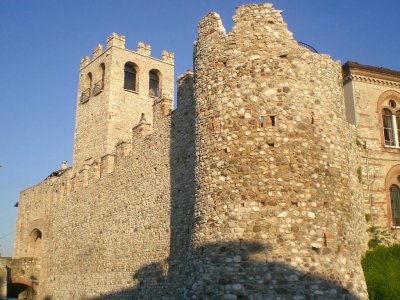Desenzano
Desenzano is the most densely populated town on the Lake Garda. Its name derives from the latin Decentius, who probably owned the Roman Villa dating back to the IV century B.C. and whose beautiful mosaics are visitable. Desenzano is stretched on a downward slope and it is said that its toponym derives from the word "discesa" (slope). The town was officially called "Desenzano" in 1926, when the ancient district of Rivoltella del Garda was suppressed and joined the adjacent district of Desenzano del Garda.
History
Desenzano has a roman origin and an ancient history. Its strategic location, on the Via Emilia, one of the most important commercial track once linking the North and the South of Italy, made the town economically powerful. In the I century B.C., the Garda area became highly popular among the noble families of Verona, the most important town in the north-east of Italy. A village gradually developed from the ruins of the Roman Villa. The name "Desenzano" is likely to derive from Decentius, who owned the same Villa. In the IV Century the town of Verona and the Monks of San Zeno Church took control of the feud which had been created, while in the XII century Desenzano was involved in the so called "Cathar Heresy", and heretical movement active till the XIV century. Many buildings existing today date back to the Venetian Period, when Desenzano was annexed to the Republic of Venice in the middle of the XV century. During the Austrian dominion, Desenzano was already well-known among noble families as a holiday location.
Best places to visit
The Castle dominates the town. Probably built as a defensive structure against the Barbaric Invasions, it was rebuilt during the period of Municipalities and reinforced in the XV century. Today it is possible to visit the walls with its four towers and the keep tower at the entrance, over the drawbridge. The Castle turned into barracks at the end of the XIX century up to 1943. Visitors can walk along the restored watch path up to the keep tower, the highest point, and enjoy one of the best views of the Lake Garda. In the rooms where the Officials were hosted, restoration works allowed to build large rooms for exhibitions or conventions.
The Cathedral of Saint Mary Magdalene was built on the ruins of an ancient church between 1586 and 1611 and designed by the architect Giulio Todeschini. The main front shows a baroque style, while the interior, composed by three aisles, is one of the best late Renaissance buildings in the area. Thanks to the prestigious painting "L'Ultima Cena" by Gian Battista Tiepolo, exposed in the SS. Sacramento Chapel, the Cathedral is even more artistically enriched.
The Roman Villa, brought to light in 1921, was probably built between the III and the IV century A.D. Today one can still admire the remains of the Villa with the colorful mosaic floors, composed by different materials. The mosaics paved all the environments of the Villa with wonderful ornamental patterns. Built around a peristyle, the southern part of the Villa shows a thermal system.
The Archeological Museum Giovanni Rambotti has been built in the cloister of St Maria del Carmine Monastery, founded in 1472. The Museum counts several rooms, each of them marking the story of the main stages from the Paleolithic to the Bronze Age and creating an historical-cultural itinerary. Many objects has been preserved and classified. Among them, the Lavagnone Plow is the most representative. Owning to the Polada culture, it is almost complete and dates back to the beginning of the Bronze Age (2000 B.C.). Visitors will also find objects from the Paleolithic, Mesolithic and Neolithic Ages, whose story is narrated by didactic dashboards.
Events
Centomiglia if you love sailing, don't miss this race, which is organized by the Gargnano Sail Boat Club every year. Desenzano has been hosting for ages the South passage buoy, which is located a few hundred meters from the breakwater. The race can be easily followed, both by boat and from lakefront.
Regata delle bisse: it deals with the Bisse championship, a race involving traditional rowing boats and taking place between the months of June and August every year.















